

After spending some time soaking up the slow paced beach vibe of Sardinia, Naples felt like a bustling city again, even though it is compact enough that you can pretty easily walk to most things you want to visit.
We wandered through the alleys below laundry strung between the buildings overhead, explored the ruins of Pompeii, and ate pizza every day. We got stuck in a downpour and had the warmest day of our time in Europe. We endured the smoking that seemed to be happening everywhere and from teenagers up to the 90 year old nonna shuffling down the street with her groceries. It felt like we had really arrived in Italy.
I also realized that I have at least in some ways become a seasoned traveler because we were warned many times both in things we read and by people we encountered about how bad the traffic is in Naples. The woman who runs the Airbnb apartment we stayed in grew somber warning us to be careful of the scooters after I chuckled a little when she described how bad the drivers were. Clearly, they have never been to Hanoi, or Yangon, or really anywhere in SE Asia because traffic was not bad. There are sidewalks and pedestrian crossings that cars respect. Scooters do zip down small streets and weave through areas that are meant to be pedestrian only it just isn’t anywhere near as overwhelming as Varanasi. I”m glad I wasn’t driving but as a pedestrian, it was not an obstacle course fraught with danger. It was a pleasant city by the bay waiting to be explored.
Day 1: We arrived in Naples in the early morning off our overnight ferry from Cagliari and had a little time to kill before we were going to be able to check-in at our Airbnb. So in Italian style, we made our way to a little cafe near where we would be staying and ordered espresso (for me) and pastries to enjoy while we watched people coming and going and one man who was trying to sell a variety of socks out of a duffel bag to people passing by.
Our Airbnb was just off Piazza Caritá and Via Pignasecca, where the street is lined with market stalls and food shops. There is a shop to buy cheese, another to buy meat, a stall or two for vegetables, and others for fish. We did not have the patience to visit six or seven different shops to put together enough groceries to feed ourselves for our time in Naples (maybe we’ll try it in Rome) and so we passed by all these vendors and moved away from the overpowering smell of fish to a grocery store.
Armed with food for breakfasts and dinners, we then felt ready to go out into the city to find our first pizza. We went to Antica Pizzeria Port’Alba where we were able to sit outside under an archway across a small alley our of the rain while we ate delicious Neapolitan pizza. For between 7 and 10 Euro you could get these beautiful pizzas fresh from the oven that just blow you away with how much better they are than any pizza you’ve had before. It was heaven. Unfortunately, our meal ended with the waiter trying to convince me that I needed to tip him because the “servicio” was not included. He hovered and tried to cajole me into giving him a little something extra until Nate pointed out that the menu clearly said the servicio was included. At which point he took our money and went away without another word. That was my cue to pay more attention to the menu in the future, and to be just as on guard for those scamming tourists here as anywhere else we’ve been.
Leaving lunch with a bad taste in our mouth, not at all caused by the pizza, we decided to take shelter from the rain under the city on a tour of the ruins that are layered beneath the city streets. We chose Napoli Sotterranea for our tour because it visits the Roman aqueducts but there is another tour a couple of blocks from there that visits a Roman marketplace instead.
We were only slightly put off when the tour started by walking through a hallway lit by blacklight and dripping red like out of some sort of haunted house. We were told by the guide that it was meant to evoke the inside of a volcano because the ruins are all made of the volcanic stone that was created by nearby Vesuvius. Luckily, the kitschy decorations ended at the entrance to the stairs that took us 40 meters down into the tunnels below the city.
The tour took about two hours and we wandered through large tunnels and small tunnels that had been used as part of the aqueduct by the Romans until a cholera epidemic led the city to dry the aqueduct. It was then used a trash dump until during WWII the trash was covered over with cement in order to use the tunnels as bomb shelters. It was just layer on layer of history under the city.
Day 2: We started our second day with a walking tour, something we hadn’t done in Barcelona. It was a tip-based tour that lasted about two hours and walked us around some of the sights we had not yet seen. Reviews had mentioned stops to get little snacks and maybe even limoncello but our tour had none of this. It was strictly sightseeing.
Still, we visited some of the main sights of the city and got some interesting tidbits we wouldn’t have otherwise.
From the walking tour, we set out to find some more pizza. Today, Pizzeria Da Michele was in our sights. The pizza was supposed to be divine and if the line outside was any indication we were in for a real treat since we hadn’t waited at all for our tasty pizza the day before. I maneuvered my way to the front of the line to get a number only to realized we were 48 while they had not yet seated 22. Too hungry to wait for an hour or more, I switched to the take-out line. Here we waited within view of the busy pizza oven and watched waiters whisk pizzas as fast as they could from the oven onto plates and out to hungry patrons. Even waiting for take-out took about 20 minutes but I emerged into the crowd with two Margarita pizzas.
The pizza was good, far better than anything we get back home, but was somewhat underwhelming considering all the commotion. I’d say that, while tasty, it was not worth the wait, though at 5 Euro a pizza it was the least expensive pizza we ate in Naples.
What is absolutely worth going out of your way for is the Sfogliatelle Riccia at Sfogliatelle Attanasio. Sfogliatelle are shell-shaped pastries with a crunchy thin outside wrapped around a soft custard-like mixture of semolina, sugar, ricotta, eggs, candied citrus peels, and a little cinnamon. Ours were fresh from the oven, warm and oozing butter. I thought the pizza the day before was heaven but I was wrong. This was most definitely heaven. It was so good, I made Nate stop again on our way to the train station on the last day for one more.
Stuffed and happy, we made our way to the National Archaeological Museum. Admittedly, I had wanted to go to the museum because I thought it was where there were casts from Pompeii that captured the way people had been frozen in the molten ash that filled the city when Vesuvius last erupted. Turns out, that’s not where they are. They are all at Pompeii. Still, we looked through the many statues and frescos that had been removed from houses and temples in Pompeii to prepare us for our trip the next day.
We chose not to pay extra for the audioguide but the signage about the many artifacts aren’t great, so in hind-sight it would have been better.
Day 3: As soon as we knew we would be coming to Naples, we knew we would make our way to Pompeii. Pompeii was a mid-size city that was somewhat average among Roman cities at the time but became extraordinary in 79 A.D. when it was buried under meters of ash and pumice after the eruption of Mount Vesuvius. Having no idea that the mountain was going to explode, despite the warning signs of earthquakes leading up to the eruption, many people stayed.
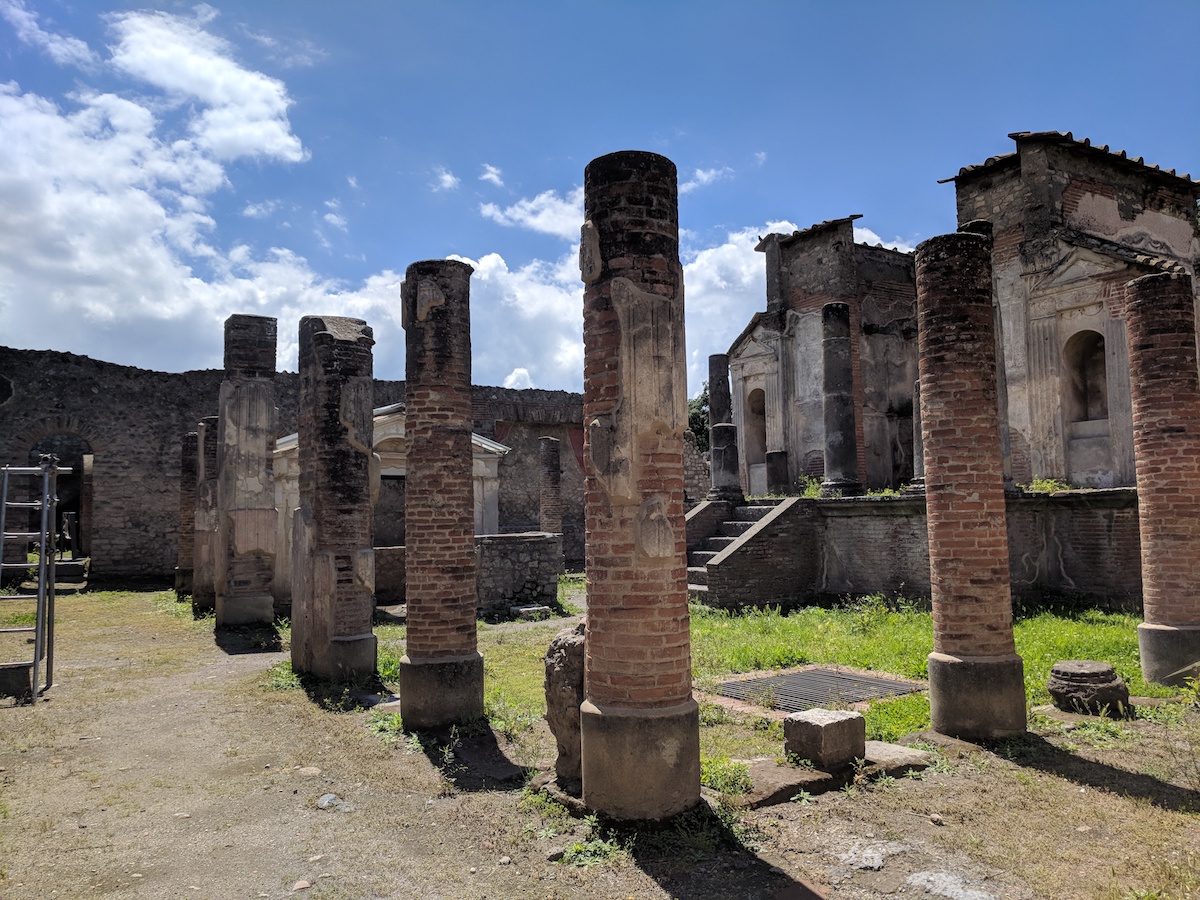
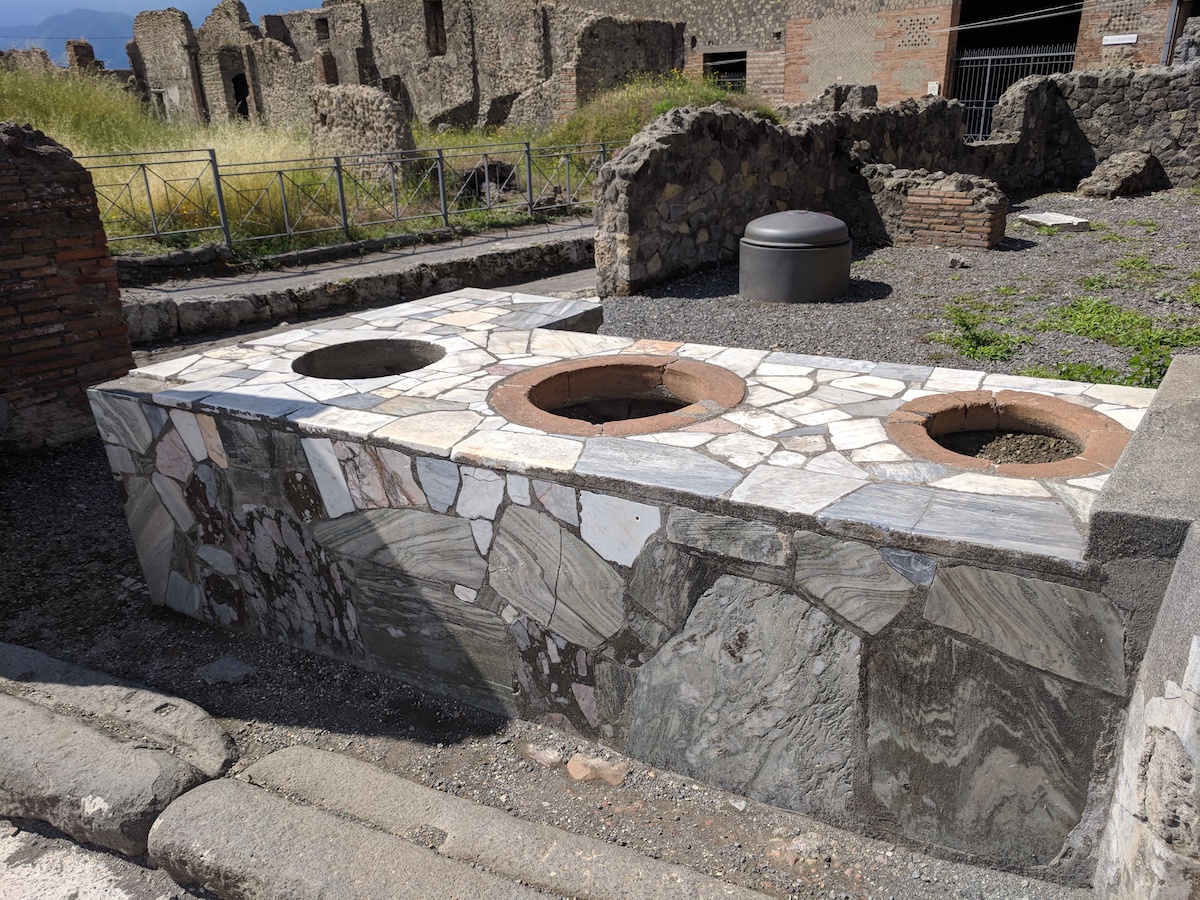
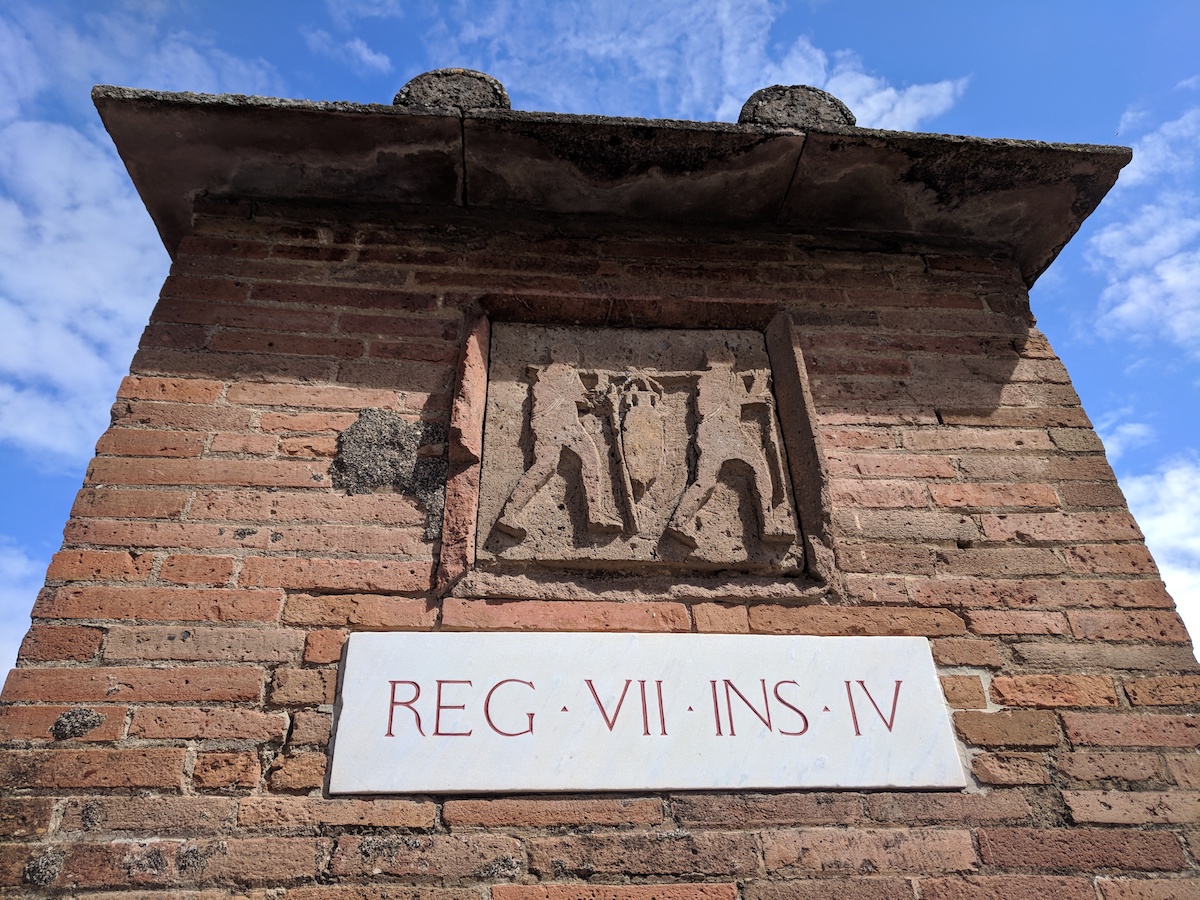
Pompeii: The Temple of Isis, a restaurant counter, and a street pictogram to indicate the street is pedestrians only.
The ruins are impressive in their scope and how well the structure of life was preserved with an unbelievable number of artifacts from pottery and household goods to artwork to the food they ate captured in the molten ash and mud. The most striking piece of the visit for me was the plaster casts. As human remains were uncovered, the archeologists and excavators noticed that the skeletons were surrounded by voids where the flesh of victims had once been. Using plaster to fill these spaces, the final poses, clothing, and faces of the last residents of Pompeii were captured. The curled body of a small child, a dog twisted in pain, and a couple embracing are all immortalized in plaster and make the death of the city more tangible than any amount of walking the streets and looking into the houses, restaurants, and baths.
We didn’t make it to Herculaneum, a smaller town that was also completely entombed in ash and mud when Vesuvius erupted but it is supposed to be even better preserved than Pompeii and is just off the same train (the Circumvesuviana) you take to get to Pompeii.
I tried something new for this visit too. Instead of paying the 5 Euro per person for an audio-guide. I downloaded a free walking tour audio-guide from Rick Steves. The narration was often a little silly, like your friends father who is constantly telling “dad jokes” was in charge, and it didn’t cover the newly opened areas of the ruins but was interesting and gave us information we very much needed given the limited signage. The information desk where you buy tickets does have maps and a pretty detailed free booklet that includes some information about each site though. We used that to fill in the gaps in the audio-guide.
After all our walking around Pompeii, it was well after our normal lunch time and I was starving. So, we exited the ruins at the gate closest to the town of Pompei (only one ‘i’ in the modern city) to find lunch. There is a very cute square just a few blocks from the museum and we walked around the surrounding streets until an Italian man sitting outside a cafe saw us looking at the menu and told us it was very good. We decided to trust him and eat at Mercato Pompeiano because we didn’t have a better option in mind and I was about to become pretty hangry if not fed soon.
We gorged ourselves on huge plates of pasta, meatballs in tomato sauce, and a plate of eggplant and squash to infuse some vegetables, though this was the most disappointing part of our meal. We ate way too much and probably should have skipped the lunchtime beer. At that point I was only fit to take a nap, which is why we did not make it to Herculaneum. Food-induced drowsiness is a real problem when you have an agenda for the day.
Instead, we got back on the train, where I could take a short nap (thankfully Nate is always willing to let me use his shoulder as my pillow), connected to a funicular up the steep hillside adjoining our neighborhood, and wandered through the tree-lined streets of the Vomero neighborhood overlooking Naples from a hill.
Day 4: For our last full day in Naples, we wandered some more. We walked just over a mile from our apartment to the Castel dell’Ovo or “Egg Castle” that is situated out in the water of the bay and provides beautiful views of the city and bay. The views were stunning but the sun was too much without any hope of shade on the roof of the castle. We were both lucky and unlucky that this turned out to be the hottest day of our time in Europe thus far.
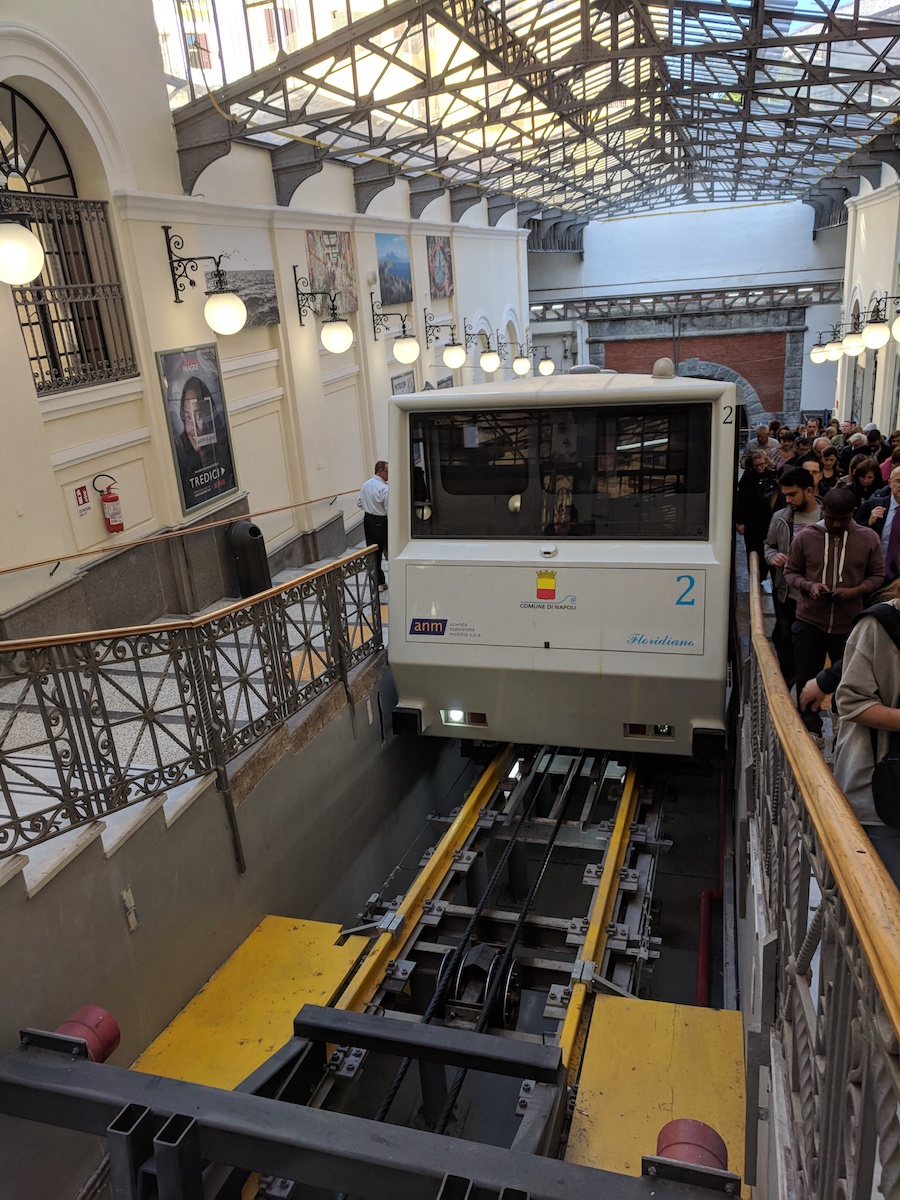
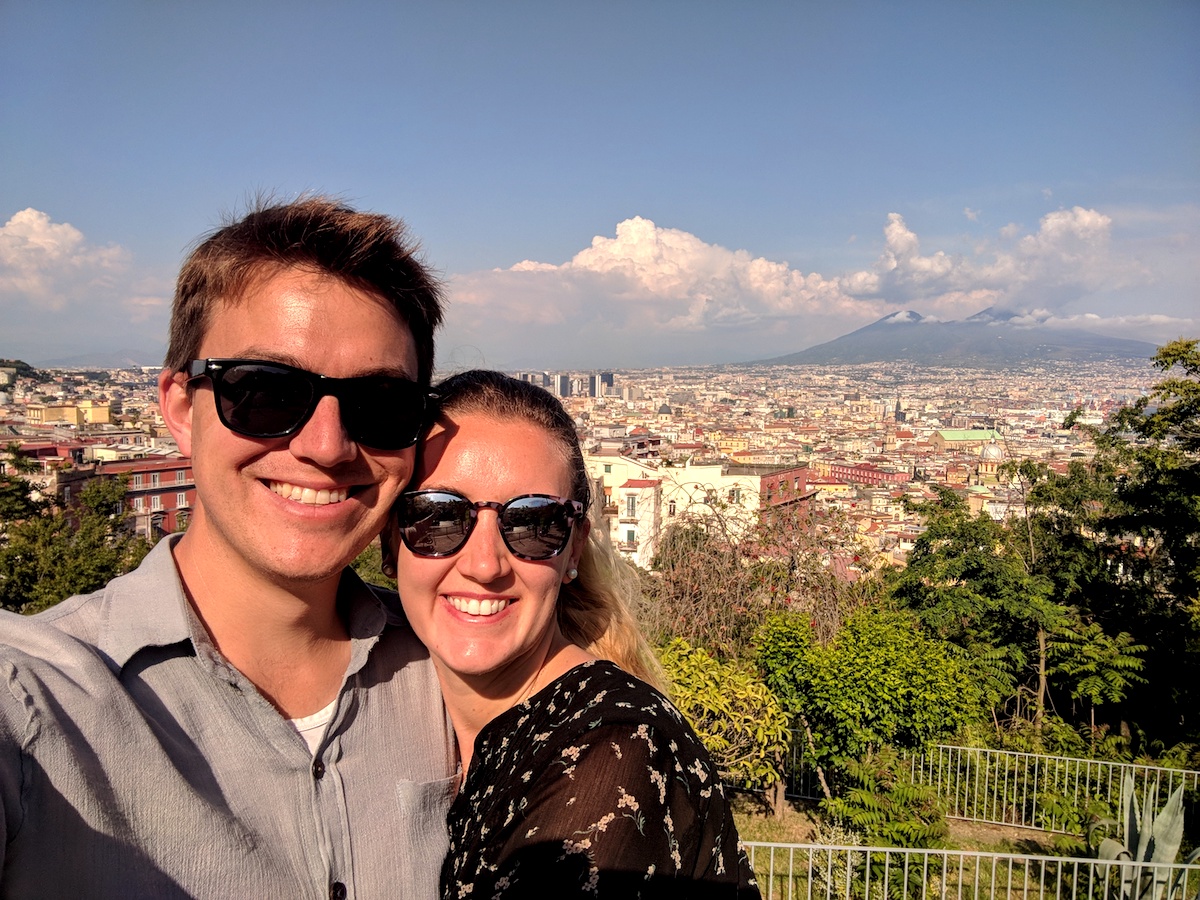

The funicular to Vomero, the view from Vomero, and a sweet treat that is a hybrid between a baba and sfogliatelle.
From there, we headed back though the streets we covered on our walking tour to enjoy a slower pace but still end up at yet another pizza restaurant, Palazzo Petrucci Pizzeria, situated in Piazza San Domenico Maggiore. The pizza was delicious and the people watching excellent.
We spent the afternoon back in Valmero but exploring the other side of the neighborhood where we found some great views over the city.
Sometimes, after days of sightseeing, all we want to do walk around soaking up the city as we go. It doesn’t sound very interesting and leads to very tired feet at the end of the day, but it’s how I get a feeling for the city more than visiting all the famous sites it has to offer.
For our time in Naples, we had budgeted as much as 85 USD a night for accommodations. We ended up finding a good Airbnb in a great location for only 75 USD per night, including Naples’ 2 euro per person per night “tourist tax”, which left us a little bit more budget for fancier pizza.
We had also budgeted 15 USD per day per person for food and 20 USD per day per person for entertainment. Out of that planned 70 USD total, we ended up spending 81 USD per day on average, including 63 USD for our luxurious lunch in Pompei and 82 USD spent on pizza meals all around the city. Overall, we ended up spending 18 USD less than we had budgeted for our full visit to Naples, which was entirely because we bought our onward train ticket to Rome far enough in advance to pay 30% less than full price!